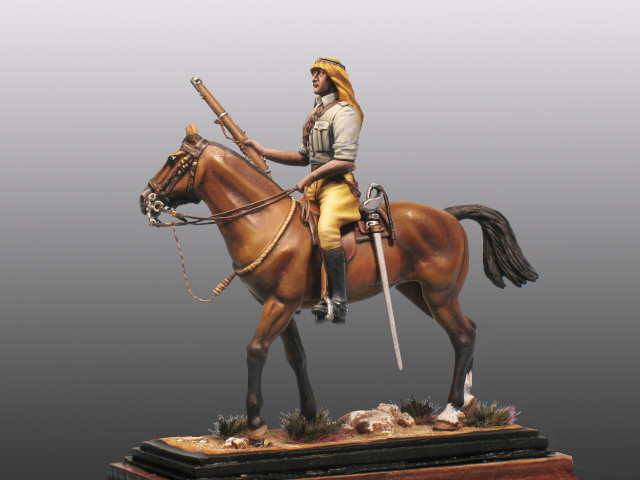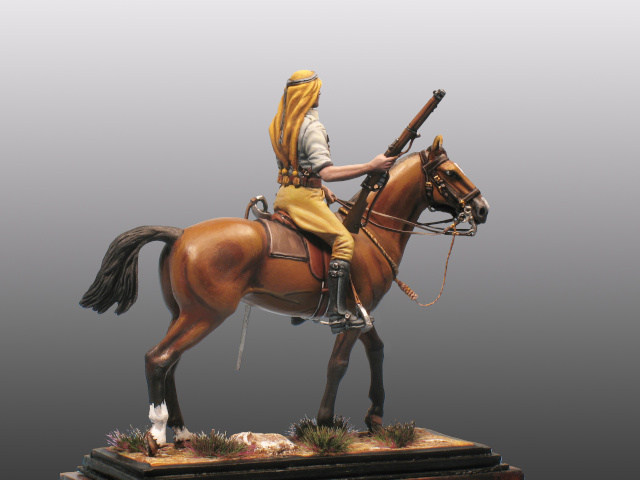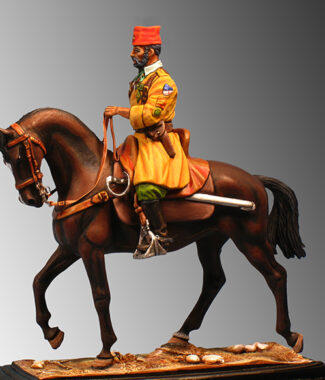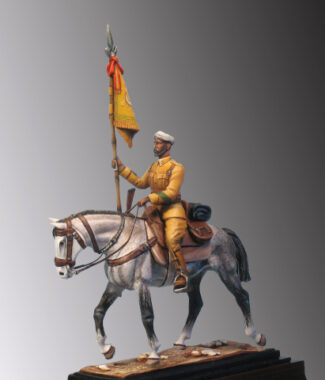You must be logged in to post a review.
Arabian Legion (Cavalry Section) – 1926.
€68.00
Figure to assemble and paint
Ref.: 10 – TC
Weight: 150 grs.
Material: White Metal
Number of Pieces: 11
Historical Review:
Transjordan was one of the few Arab nations to gain full independence at the end of the First World War. From then on, holding the status of a fully sovereign country, albeit under the orbit of the UK in exchange for protection from other powers, the nation raised its own shock force that would come to be known as the Arab Legion and would distinguish itself fiercely during the Second World War and the Arab Israeli War.
The British Army occupying Transjordan at the end of the Great War authorised in 1920 the creation of a Mobile Force composed of 150 Arab auxiliaries to be distributed as follows: 100 men (75 horsemen and 25 soldiers) to be deployed at Zarqa to control the Amman Road; and another 50 to be stationed at Kerak Square. Under the command of the highly regarded British adviser Frederick Gerard Peake, former partner of the legendary officer Thomas Edward Lawrence ‘Lawrence of Arabia’ during the Arab Revolt against the Ottoman Empire, only 20% of the troops were Arab because the remaining 80% came from Chechnya and the areas of the Caucasus contested between Russia and Turkey.
The year after the creation of the Mobile Force in 1921, the Kingdom of Transjordan decided to organise its own armed forces by raising a force of 200 Arabs in Amman, at the time a very small contingent for such a large desert to control. In fact, their small numbers and poor training meant that after being sent to the northwest of the Emirate to crush a Bedouin uprising, the rebels ambushed the Arab soldiers, killing 18 horsemen and capturing all their horses. Controversy over this defeat led the Transjordanian government to merge its so-called ‘Transjordanian army’ with the Mobile Force previously promoted by the British Army. Out of this merger came the Mobile Reserve Force consisting of two infantry companies, three cavalry squadrons, a mountain artillery battery, a machine gun company and a transmission section. However, this initiative soon became obsolete as well, as the authority’s relaxed recruitment to a total of 1,000 volunteers, mostly Transjordanian veterans of the defunct Ottoman Army, which led on 22 October 1923 to the Mobile Reserve Force changing its name to the Arab Legion (Al Jeish al Arabi).
Officially, the Arab Legion’s baptism of fire took place in 1924 on the Transjordan border with Saudi Arabia, a desert area where it successfully confronted the radical Muslim faction of the ‘Wahhabists’. The consequences of this victory were positive for the Arab Legion, which quickly increased its strength to 1,500 men. From 1926 onwards, the Arab Legion was used for security duties, usually for border guarding the Arabian Peninsula, Egypt and Iraq, as well as guarding various desert roads, such as the road from Jerusalem to Amman.
From the early 1930s, the Arab Legion underwent notable changes as the usual horse or camel riders with which its members moved for combat were assigned modern Wagner vehicles and state-of-the-art weapons such as Lewis or Vickers cannons and machine guns. Its internal structure was also modified by removing the mountain artillery battery and the transmission section, but adding new companies of infantry, cavalry, motorised, urban guard and the Desert Patrol, the latter consisting of 20 soldiers in 4 armoured trucks to protect the cultivated areas on the banks of the Jordan River. All these improvements were noted from 1936 onwards when the Arab Legion was called into Syria to crush a series of civil revolts, actions in which it distinguished itself effectively and for which it was highly valued in the eyes of British and Transjordanian statesmen. As a result of these successes over Syria, the Transjordanian commanders opted to increase the Arab Legion’s forces by creating new units such as the Combat Reserve Force of two cavalry squadrons, plus the Desert Mechanised Force based in Jaffa, which consisted of 350 Bedouins in two truck companies and six armoured vehicles. Also, in 1938 a Transjordanian military officer, General Abdul Qadir Pasha Al Jundi, was appointed commander, but supervised by the British adviser John Bagot Glubb, who was to be nicknamed by the Arabs with the ironic nickname ‘Pasha Glubb’.
The figure is based on photographs of the period. A distinctive feature of the Arab Legion was the keffia, the classic Bedouin headscarf, which they wore as a head covering, a garment that was also essential for defence against the desert wind. The cavalry section of the Arab Legion, which, as a distinctive sign, had yellow keffias. The rest of the horse’s uniform and equipment was of British origin. As a weapon he carries the British Army’s standard issue rifle, the Lee-Enfield Mark III.








Reviews
There are no reviews yet.